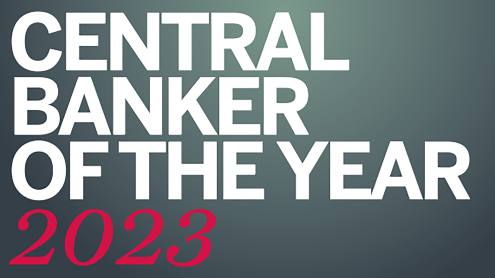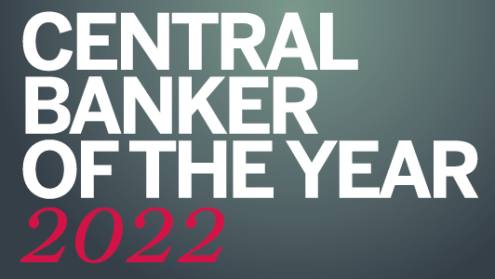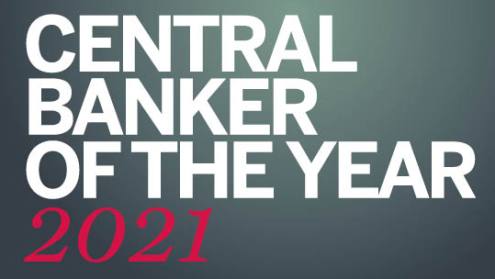Global and Middle East
Mubarak Rashed Al Mansoori, United Arab Emirates
Mubarak Rashed Al Mansoori, the winner of this year’s Global Central Bank Governor of the Year award, has not had an easy time since taking the helm of the United Arab Emirates central bank in September 2014. Persistently low oil prices have cooled economic growth prospects across the economy, with the non-oil sector in particular falling victim to fiscal consolidation measures in 2015. Gross domestic product growth is expected to hit just 2.3% in 2016, before improving slightly to 2.5% in 2017, according to the International Monetary Fund.
These conditions have placed new pressures on the country’s banking sector – the largest in the Middle East – as asset quality and liquidity indicators feel the pinch. A reduction in the deposit base of the government and government-related entities in recent years has been a particular challenge. This has been compounded by rising credit demand in the latter stages of 2016, leading to a rise in the Emirates Interbank Offered Rate.
But the UAE financial sector is tackling these problems from a position of strength. Mr Al Mansoori, building on the work of his predecessors, has prudently managed the stability of the banking sector by shoring up capital and liquidity positions. The capital adequacy ratio of the country’s banks sits at just over 18% (16.9% for Tier 1 capital).
Meanwhile, the liquid assets ratio of the sector has climbed from 14.2% in the third quarter of 2015 to 15.7% in the same quarter of 2016. Under Mr Al Mansoori’s leadership, the Central Bank of the UAE (CBU) ensured banks’ credit risks were well provisioned before the distribution of their 2015 profits.
In May 2015, a central bank circular directed the country’s lenders to develop a liquidity risk management framework in line with Basel III liquidity standards. The first step in this process involved UAE banks complying with the eligible liquid assets ratio, requiring 10% of their liabilities to be eligible liquid assets by July 2015.
Compliance with the liquidity coverage ratio (LCR), the next step in meeting Basel III liquidity standards, is being determined on a bank-by-bank basis by the CBU, and began in January 2016. Banks compliant with the LCR will also be required to meet net stable funding ratio metrics by January 2018, and the CBU is also migrating the banking sector towards Basel III capital standards by 2018.
Meanwhile, the CBU has been preparing, in partnership with other government agencies, new regulatory initiatives designed to strengthen its oversight and supervision in the UAE. These include the adoption of a new central bank and banking law to augment the independence and governance of the CBU, and a new public debt law that will foster the rise of debt capital markets in the country. In 2015, the CBU also distributed several circulars intended to improve standards of corporate governance among local banks.
Beyond these regulatory reforms, Mr Al Mansoori is taking a leading role in mitigating the impact of de-risking on the UAE financial sector. More globalised than many other regional economies and with a higher proportion of small and medium-sized enterprises and exchange houses, the UAE has been suffering from the termination of correspondent banking relationships in recent times.
To address this, the CBU, through its anti-money laundering and countering the financing of terrorism unit, is working closely with the UAE Banks Federation to enhance capacity building among local banks as well as with regional and international regulators and agencies to improve the harmonisation of efforts to tackle issues arising from de-risking.
In the sphere of Islamic finance, in May 2016 the UAE formally approved the creation of a centralised sharia authority to oversee the operations of domestic Islamic banks.
Since Mr Al Mansoori assumed the leadership of the CBU, the Middle East region’s largest and most complex banking market has become more stable and better regulated. For these reasons and others, he has emerged as the global winner of the Central Bank Governor of the Year award.
Central Banker of the Year, Europe
Elvira Nabiullina, Russia
Russia’s central bank has had its work cut out over the past few years: manoeuvring the country out of an economic crisis coupled with currency devaluation and banking sector troubles. But the strong hand of governor Elvira Nabiullina has helped steer the country through the difficulties, and it looks set to return to economic growth in 2017, if at a low rate of 1.1%, according to International Monetary Fund forecasts.
Having started 2016 with consumer price inflation of 12.9% – highs not seen since 2008 – Ms Nabiullina highlighted the need to lower inflation to improve economic growth in Russia. In a country where (according to International Monetary Fund data going back to 1992) inflation had never fallen below 6.1%, Ms Nabiullina’s efforts saw the rate drop below 6% by the end of 2016.
“Importantly, in 2016 there was a turning point in the sentiment of the population and professionals regarding inflation expectations,” she says. “At the beginning of 2016, inflation expectations of market participants were well above our target, but now they have reduced to close to our [end-2017] 4% inflation target, at between 4.5% and 4.7%.”
Lower inflation should also translate into falling interest rates, something Russia’s bankers are hoping for. In 2016, rates were lowered by 1 percentage point to end the year at 10%.
Ms Nabiullina has also made a name for herself thanks to her unflinching position on cleaning up the Russian banking sector. Since 2014, Bank of Russia has withdrawn more than 300 banking licences from institutions that were either chronically weak or unscrupulously led – amounting to one-third of Russia’s credit institutions.
“But we haven’t yet completed the resolution of the banking sector and our target for 2017 is to raise the efficiency of our banking supervision so that it is proactive and follows our risk-based approach,” she says.
According to Bank of Russia’s assessment, financial institutions as a whole have become more resilient to external shocks since the difficulties of 2014 and 2015 and their capitalisation is now “sufficient to continue to fund the economy”, while non-performing loan ratios did not grow in 2016.
Ms Nabiullina is working on 2017 plans for a new pension savings concept drawn up together with Russia’s finance ministry, another sector she supervises. “Pension savings should become the most important source of long-term money for the Russian economy,” she says. “We hope that this project is going to be adopted by parliament in 2017.”
Central Banker of the Year, Asia-Pacific
Le Minh Hung, Vietnam
Back in 2011, Vietnam’s financial sector grappled with a banking crisis caused by high non-performing loans (NPLs) and poor risk management. Part of the problem, said pundits, was complacent and reactive regulation.
But since then, State Bank of Vietnam (SBV), the country's central bank, has pushed for regulatory reforms to reduce NPLs and to tighten scrutiny of the banking sector. Despite being appointed only in April 2016, Le Minh Hung, the youngest SBV governor to date, has pushed this reformist momentum ahead and has already launched brand new reforms of his own.
In May 2016, the SBV tightened regulations on asset liability management and real estate loans to slow the growth of banks’ exposure to this sector. This was crucial in light of the fact that rapid credit expansion to Vietnam’s real estate industry had contributed heavily to the 2011 banking crisis. The SBV raised the risk weights for real estate loans from 150% to 200%, as of the end of 2016.
To improve asset liability management, the SBV cut the maximum ratio for short-term funding for loans longer than 12 months from 60% to 50% by the end of 2016. The ratio will drop to 40% by the end of 2017.
As a way to help banks resolve their NPLs, the government set up the Vietnam Asset Management Company (VAMC) in 2013. But instead of buying NPLs from banks, the VAMC was set up to give banks five- or 10-year 0% coupon bonds in exchange for a bundle of NPLs. During the life of the bonds, NPLs sit on the VAMC’s balance sheet rather than the banks’ own. But if banks do not resolve the NPLs before the VAMC bonds mature, the VAMC transfers the stressed assets back to the bank. Market participants see this as a key limiting factor to resolving the issue of non-performing assets.
But in 2016, the VAMC announced it would make its first cash purchase of NPLs from banks. The company’s capacity to do so is still somewhat limited, but this reform will finally allow for all economic risks associated with an NPL to be transferred away from banks and to the VAMC.
Additionally, the SBV demonstrated its commitment to regional banking integration when it approved in principle a plan to set up a wholly foreign-owned bank in Vietnam by South Korea’s Woori Bank.
Central Banker of the Year, Americas
Carlos Fernandez Valdovinos, Paraguay
Not always getting the recognition it deserves, Paraguay has made great efforts to support its swift economic growth with ongoing upgrades of public policies and regulation. Gross domestic product growth has averaged 4.8% over the past 12 years, with peaks of more than 13% and 14% in 2010 and 2013, respectively. In 2016, when Latin America's economy as a whole contracted by an estimated 0.6%, Paraguay is on track to have expanded by 4%.
The institutions that helped propel, and then sustain, economic growth also deserve their share of praise. Paraguay’s central bank has kept inflation low and stable at right under its 4.5% target for 2016, while adopting an accommodative monetary policy to sustain dips in growth because of weaker conditions elsewhere in the region (particularly in Brazil, its largest trading partner), and lower commodities prices.
“Any further monetary move to support economic activity will take place in a timely manner and be conditional on inflation expectations remaining well anchored,” says central bank governor Carlos Fernandez Valdovinos, the winner of The Banker's Central Bank Governor of the Year award for the Americas.
Furthermore, Mr Valdovinos has concentrated on reforms that he says were overdue but which the bank could not entirely focus upon until recently. Examples include an update of the banking law, now approved by Congress, which gives lenders greater flexibility in dealing with changed market conditions and reforms the central bank charter aimed at strengthening governance.
In late 2015, he introduced measures to facilitate the restructuring of non-performing loans, a simple yet uncommon practice in the local market.
“These legal reforms are necessary to secure financial stability over the medium term,” says Mr Valdovinos. “During the 1990s, the banking crisis in Paraguay had enormous economic and social costs. We learned the hard way, so with these laws we are setting the ground for a financial sector that will enrich economic development and not become an obstacle, as it was in the past.
“I am very honoured and grateful to receive this prestigious award, which recognises the hard work of a talented and committed team that, for more than a decade, has been strengthening our central bank’s technical capacity. The effectiveness of our policy decisions, to achieve price and financial stability, is grounded in the quality of our institution’s human capital, which is also at the heart of our credibility.”
Central Banker of the Year, Africa
Rameswurlall Basant Roi, Mauritius
Mauritius has always been a beacon of stability in a region that, at times, can present investors with various political and operational uncertainties. Boasting a transparent and well-regulated business environment, the Mauritian economy is one of the most globalised in Africa.
The financial sector is no exception, as the country’s banks have developed a sizeable footprint across southern and eastern Africa, as well as the Indian Ocean islands, south Asia and beyond. But this openness leaves Mauritius exposed, like few other regional markets, to the ebbs and flows of the global economy. The ongoing slowdown in the island’s key trading partners, the UK and eurozone, has adversely impacted growth in recent years.
“The lasting economic morass in the eurozone has been and is continuing to be a serious drag on the country's economy. Brexit dealt yet another blow to our export sector in 2016. Despite these strong headwinds, the economy has displayed a remarkable degree of resilience. Gross domestic product growth for 2016 is expected to be just over 3% in 2016,” says Rameswurlall Basant Roi, governor of the Bank of Mauritius.
The Bank of Mauritius has played a pivotal – if unsung – role in stabilising the economy in recent years. Under the leadership of the current governor, the central bank has taken bold action to augment its regulatory oversight (often through the rationalisation of regulations) and to calibrate monetary policy in a way that has supported growth while maintaining balance in the economy. Tackling excess liquidity in the island nation has been one such success.
“Successive years of capital inflows had generated massive amounts of liquidity that were left unsterilised because of cost considerations. The bank adopted a smart monetary management strategy in 2015, as a result of which the liquidity problem has been almost eliminated. Monetary instability that threatened overall macro-economic stability has been avoided,” says Mr Roi.
Elsewhere, the Bank of Mauritius is taking a number of important steps to improve the efficiency of the economy. This includes the introduction of a deposit insurance scheme and the introduction of an asset management company to address non-performing assets, both of which are expected to be operational in 2017.






